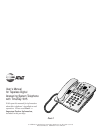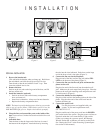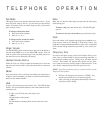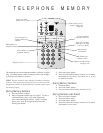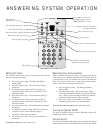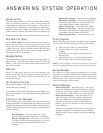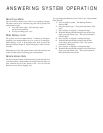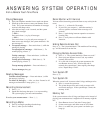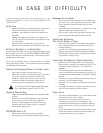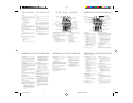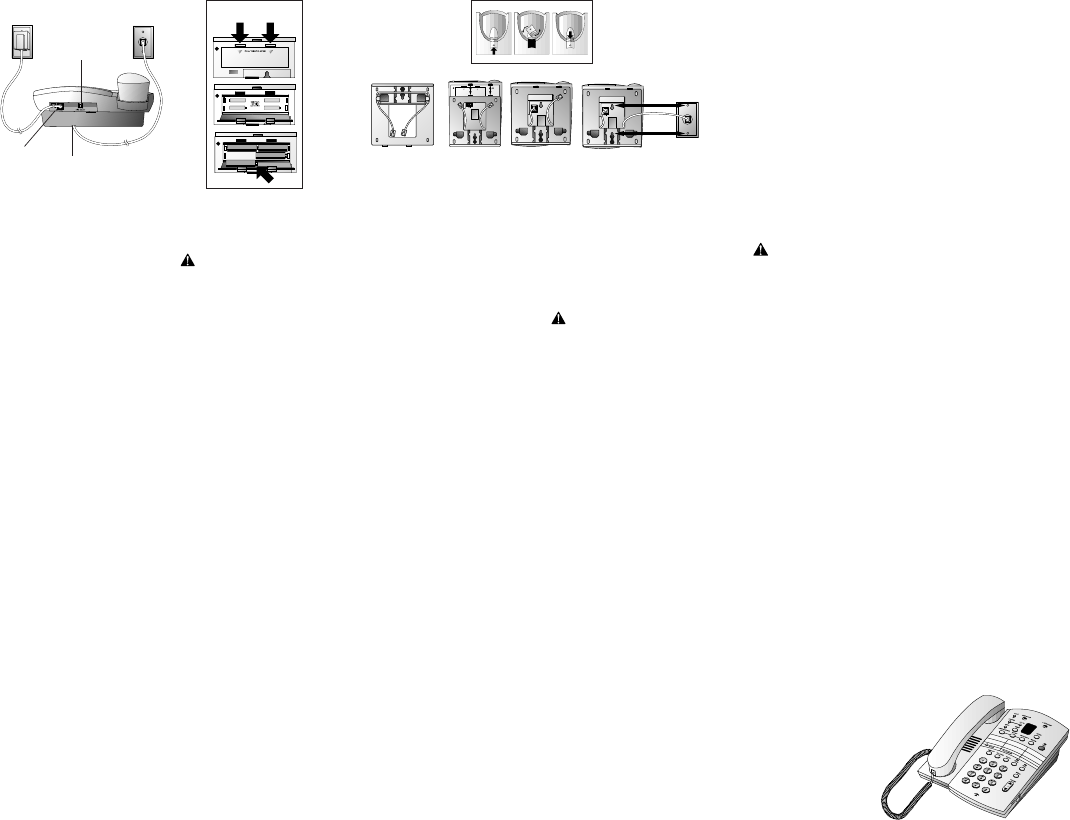
Part 2
User's Manual
for Tapeless Digital
Answering System Telephone
with Time/Day 1815
Fold open this manual for information
about this telephone's installation and
operation. Please read Part 1 —
Important Product Information,
included in this package.
1
© 1998 Lucent Technologies Consumer Products L.P. All rights reserved.
Printed in Mexico. 848229571 Issue 2AT&T
FOR TABLE/DESK INSTALLATION
1 Install the batteries (optional).
• Turn the unit upside down.
• Push in on the two tabs at the large end of the base, and
lift the base off the unit.
• Push in on the two tabs on the battery compartment
door, and remove it.
• Insert four AA batteries. Always use four new batteries.
• Replace the battery compartment door.
• Reattach the base by inserting the tabs into the slots.
Push down on the large end of the base to lock it into
place. Make sure the larger end is toward the top of
the telephone. The telephone should sit flat on your
table or desk during use.
NOTE: The batteries provide backup power, allowing you to make
calls in case of a power failure. When battery power is low, the
LOW BATTERY light goes on. Replace the batteries promptly.
2 Connect the line cord to the telephone.
Plug one end of the line cord into the jack labeled TEL
LINE on the bottom of the telephone. Run the line cord
through the channel on the bottom of the phone.
INSTALLATION
Battery Installation (optional)
RING SELECT
POWER
Telephone Line Cord
3 Connect the handset to the telephone.
Plug the coiled cord into the handset jack on the side of
thephone. Plug the other end of the coiled cord into the
handset, then hang up.
4 Connect the line cord to a wall jack.
Plug the free end of the line cord into a telephone wall jack.
Make sure the cord snaps firmly into place.
5 Connect the power cord.
Use only the power cord supplied with your
system. If you need a replacement cord,
call 1 800 222–3111.
Fit the power cord behind the strain relief tab. Then, plug the
smaller end of the power cordinto the POWER jack on the
back of the system. Plug the power cord into an electrical
outlet that is not controlled by a light switch. (When you
connect the system to power, the Message Window flashes
CL to indicate you need to set the clock. See “Setting the
Clock” in theAnswering System Operation section of this
manual.)
FOR WALL INSTALLATION
1 Reverse the handset tab.
(This tab holds the handset when you hang up.) Hold down
the switchhook, and slide the tab up and out of its slot.
Turn the tab so that the end with the “hook” is up. Then
insert the tabback into its slot.
2 Remove the base.
Push in on the two tabs at the large end of the base, and lift
the base off the unit.
3 Install the batteries (optional).
• Push in on the two tabs on the battery compartment
door, and remove it.
• Insert four AA batteries. Always use four new batteries.
• Replace the battery compartment door.
NOTE: The batteries provide backup power, allowing you to make
calls in case of a power failure. When battery power is low, the
LOW BATTERY light goes on. Replace the batteries promptly.
4 Wrap the line cord around the posts on the inside of the
base. Leave at least 3 inches free at each end of the line cord
(Figure 1).
5 Attach the base.
Turn the base so that the larger end of the base is toward
the bottom of the telephone. Attach the base by inserting
INSTALLATION
PULL TABS TO OPEN
PULL TABS TO OPEN
PULL TABS TO OPEN
Figure 1 Figure 2 Figure 3 Figure 4
Reverse the Handset Tab
123
the tabs into the slots indicated. Push down on the large
end of the base to lock it into place (Figure 2).
6 Connect the line cord to the telephone.
Plug one end of the line cord into the jack labeled TEL
LINE on the bottom of the phone (Figure 3).
7 Connect the line cord to the wall jack, and mount the
phone on the wall.
Plug the free end of the line cord into the modular wall
jack. Make sure the cord snaps firmly into place. Place the
phone on the wall jack mounting studs and pull down until
it is heldsecurely (Figure 4).
8 Connect the handset to the telephone.
Plug the coiled cord into the handset jack on the side of the
phone. Plug the other end of the coiled cord into the
handset, then hang up.
9 Connect the power cord.
Use only the power cord supplied with your
system. If you need a replacement cord,
call 1 800 222–3111.
Plug the smaller end of the power cord into the POWER
jack on the back of the system. Plug the power cord into an
electrical outlet that is not controlled by a light switch.
(When you connect the system to power, the Message
Window flashes CL to indicate you need to set the clock.
See “Setting the Clock” in the Answering System Opera-
tion section of this manual.)
If this answering system does not work properly, try the
following suggestions. If you’re still having difficulty, call
1 800 222–3111.
No Dial Tone
• Make sure all plugs are connected properly. Check the
line cord connections at the wall jack and at the
telephone. Also check the coiled cord connections at
both ends.
• Unplug the telephone and connect it to another wall
jack. If you still have no dial tone, the problem is with
your phone line.
• If the system is not connected to AC power and
batteries are not installed, you will not hear a dial tone.
Call Cannot Be Dialed, or Is Dialed Slowly
If you have pulse dialing service, you cannot dial numbers with
the dial mode set to tone. See the TELEPHONE OPERATION
section of this manual to set the dial mode. Set the mode to pulse,
then hang up and dial again.
If you have tone dialing service, you may be able to use either
tone or pulse dialing mode. If you set the mode to tone, numbers
are dialed much more quickly.
Problems with Message Window or Indicator Lights
• Press O to make sure the system is on.
• Make sure all plugs are connected properly. Check the
line cord connections at the wall jack and at the
telephone. Make sure the power cord is securely
connected to both the answering system and an
electrical outlet not controlled by a wall switch.
Use only the power cord supplied with this product.
For a replacement, contact 1 800 222–3111.
Telephone Does Not Ring
• Make sure the RINGER switch is set in the LO or HI
position.
• If there are several other telephones on the same line,
try disconnecting some of the other telephones.
Having too many telephones connected can create
problems such as low ringer volume, or impaired
sound quality during calls.
LOW BATTERY Light Is On
• Make sure the batteries are correctly installed.
• If the light stays on, replace the batteries with 4 new ones.
Messages Are Incomplete
• The system can accept messages up to 3 minutes long.
If a caller leaves a very long message, part of it might
be lost when the system disconnects the call after
3 minutes.
• If the caller pauses for more than 7 seconds, the system
stops recording and disconnects the call.
• If the system’s memory fills up during a message, the
system stops recording and disconnects the call.
System Does Not Answer
After Correct Number of Rings
• If the Toll Saver feature is in operation, the number of
rings changes from four to two when you have new
messages waiting.
• In some cases, the system might be affected by the
ringing system used by the local telephone company.
• If the system’s memory is full, or the system is off, the
system answers after 10 rings.
System Does Not Respond to Remote Commands
• Make sure you are calling from a touch tone phone.
When you dial a number, you should hear tones. If you
hear clicks instead, the phone is not a touch tone
telephone.
• The answering system may not detect the Remote
Access Code while your announcement is playing. Try
waiting until the announcement is over before entering
the code.
• There may be noise interference on the phone line you
are using. Press dial buttons firmly.
• Make sure you are entering your Remote Access Code
correctly.
• You might be calling from a phone that sends tones too
short for your answering system to detect.
Power Failure
• If you have installed batteries, you will be able to make
calls in the event of a power failure.
• If the system is disconnected from AC power
answering system features will not operate. Your
announcement and messages are retained in memory
during apower failure, but you will need to reset the
clock.
• The system operates in dial pulse mode during a power
failure, but returns to whatever dial mode setting you
have selected when power is returned.
IN CASE OF DIFFICULTY
1815 map_2ATTM1



